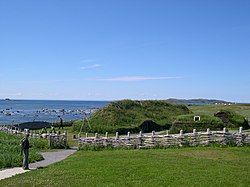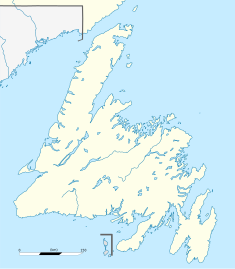L'Anse aux Meadows
Suratan niki patut katerjemahang saking basa Inggris ka basa Bali. Suratan niki kasurat utawi katerjemahang durung becik saking Wikipedia basa Inggris. Yening kaca niki katujuang sareng komunitas basa Inggris, kaca nika pinih becik magenah ring Wikipédia basa Inggris. Cingak lis basa Wikipedia. Suratan sane nenten katerjemahang dados kausap manut kriteria A2. Yéning ida dané kayun nureksa suratan niki, Ida dané dados nganggén mesin panerjemah. Nanging ten engsap, ten dados nyalin asil terjemahan punika ka suratan, yadiastun kasub dados terjemahan makualitas kirang becik. |
51°35′47″N 55°32′00″W / 51.59639°N 55.53333°W
| L'Anse aux Meadows | |
|---|---|
 Wangunan Norse sané kaadegang malih ring L'Anse aux Meadows | |
| Koordinat | 51°35′47″N 55°32′00″W / 51.59639°N 55.53333°W |
| Situs web | Situs Lelintihan Nasional L'Anse aux Meadows |
| Aran resmi: Situs Lelintihan Nasional L'Anse aux Meadows | |
| Soroh | Budaya |
| Kriteria | vi |
| Katetapang | 1978 (sési ka-2) |
| 4 | |
| Negara | Kanada |
| Wawengkon | Éropa miwah Amérika Kalér |
Invalid designation | |
| Aran resmi: Situs Lelintihan Nasional L'Anse aux Meadows Kanada. | |
| Katetapang | 28 Nopémber 1968 |
Genah L'Anse aux Meadows ring Newfoundland | |
L'Anse aux Meadows (/ˈlænsi
Antuk analisis lingkehan taru saking tiga struktur ring situs sané maasal saking warsa 1021[4] and a mean carbon date of 1014 overall,[2] L'Anse aux Meadows is the only undisputed site of pre-Columbian trans-oceanic contact of Europeans with the Americas outside of Greenland.[3] It is notable as evidence of the Norse presence in North America and for its possible connection with Leif Erikson as mentioned in the Saga of the Greenlanders and the Saga of Erik the Red,[5] which were written down in the 13th century.[3] Archaeological evidence found at the site indicates that L’Anse aux Meadows may have served as a base camp for Norse exploration of North America, including regions to the south.[6]
Spanning 7,991 héktare (30.85 sq mi) of land and sea, the site contains the remains of eight buildings constructed with sod over a wood frame. In excess of 800 Norse objects have been unearthed at the site.[7] Evidence of iron production and bronze, bone and stone artifacts have been identified.[8] The site was designated a National Historic Site of Canada in 1968 and a World Heritage Site by UNESCO in 1978.[9] Parks Canada manages the site as outlined under the Parks Canada Agency Act (1998) and the Canada National Parks Act (2000).[10] It is the only confirmed Norse site in or near North America outside of the villages and settlements of Greenland.[11][12]
- ↑ Nydal, Reidar (1989). "A Critical Review of Radiocarbon Dating of a Norse Settlement at L'Anse Aux Meadows, Newfoundland Canada". Radiocarbon. 31 (3): 976–985. doi:10.1017/S0033822200012613. eISSN 1945-5755. ISSN 0033-8222.
With an assumed total systematic error of 30 ± 20 years, as a mean for various tree rings, the calibrated age range of L'Anse aux Meadows is AD 975–1020. This agrees well with the assumed historical age of ca AD 1000, a result which has also been recently corroborated by high-precision accelerator dating at the University of Toronto.
- ↑ 2,0 2,1 Cordell, Linda S.; Lightfoot, Kent; McManamon, Francis; Milner, George (2009). "L'Anse aux Meadows National Historic Site". Archaeology in America: An Encyclopedia. ABC-CLIO. p. 82. ISBN 978-0-313-02189-3.
This is a substantial base for analysis , which yields an entirely credible range of dates between 990 and 1050 and a mean date of 1014 CE , which is popularly rounded off at 1000 CE .
- ↑ 3,0 3,1 3,2 Ledger, Paul M.; Girdland-Flink, Linus; Forbes, Véronique (15 July 2019). "New horizons at L'Anse aux Meadows". Proceedings of the National Academy of Sciences. 116 (31): 15341–15343. doi:10.1073/PNAS.1907986116. eISSN 1091-6490. ISSN 0027-8424. PMC 6681721. PMID 31308231.
Modeling results were remarkably consistent, and model A suggests Norse occupation began Cal AD 910–1030..... A weighted mean of twig dates—notwithstanding issues associated with combination of 14C ages from multiple individuals—provided a result of AD 986–1022
- ↑ Kuitems, Margot; Wallace, Birgitta L.; Lindsay, Charles; Scifo, Andrea; Doeve, Petra; Jenkins, Kevin; Lindauer, Susanne; Erdil, Pınar; Ledger, Paul M.; Forbes, Véronique; Vermeeren, Caroline (20 October 2021). "Evidence for European presence in the Americas in AD 1021". Nature (ring Inggris). 601 (7893): 388–391. doi:10.1038/s41586-021-03972-8. ISSN 1476-4687. PMC 8770119 Check
|pmc=value (help). PMID 34671168 Check|pmid=value (help). S2CID 239051036 Check|s2cid=value (help).Our result of AD 1021 for the cutting year constitutes the only secure calendar date for the presence of Europeans across the Atlantic before the voyages of Columbus. Moreover, the fact that our results, on three different trees, converge on the same year is notable and unexpected. This coincidence strongly suggests Norse activity at L'Anse aux Meadows in AD 1021. In addition, our research demonstrates the potential of the AD 993 anomaly in atmospheric 14C concentrations for pinpointing the ages of past migrations and cultural interactions.
- ↑ Wallace, Birgitta (2009). "L'Anse aux Meadows, Leif Eriksson's Home in Vinland". Journal of the North Atlantic: 115. ISSN 1935-1984. JSTOR 26686942.
- ↑ Kuitems, Margot; Wallace, Birgitta L.; Lindsay, Charles; Scifo, Andrea; Doeve, Petra; Jenkins, Kevin; Lindauer, Susanne; Erdil, Pınar; Ledger, Paul M.; Forbes, Véronique; Vermeeren, Caroline; Friedrich, Ronny; Dee, Michael W. (January 2022). "Evidence for European presence in the Americas in ad 1021". Nature (ring Inggris). 601 (7893): 388–391. Bibcode:2022Natur.601..388K. doi:10.1038/s41586-021-03972-8. ISSN 1476-4687. PMC 8770119 Check
|pmc=value (help). PMID 34671168 Check|pmid=value (help). - ↑ Sarolta Anna Takacs; Eric H. Cline (17 July 2015). The Ancient World, Volumes 1–5. Routledge. pp. 272–. ISBN 978-1-317-45839-5.
- ↑ Kirsten Wolf (2004). Daily Life of the Vikings. Greenwood Publishing Group. pp. 139–. ISBN 978-0-313-32269-3. OCLC 253909682.
- ↑ "L'Anse aux Meadows National Historic Site". UNESCO World Heritage Center.
L'Anse aux Meadows is the first and only known site established by Vikings in North America and the earliest evidence of European settlement in the New World. As such, it is a unique milestone in the history of human migration and discovery.
- ↑ "ENVIRONMENT". www.ourcommons.ca. Kaarsipin saking versi asli tanggal 2022-10-09. Kaaksés 2022-10-09.
- ↑ Wallace, Birgitta (2003). "The Norse in Newfoundland: L'Anse aux Meadows and Vinland". Newfoundland and Labrador Studies. 19 (1).
- ↑ Bird, Lindsay (30 May 2018). "Archeological quest for Codroy Valley Vikings comes up short – Report filed with province states no Norse activity found at dig site". Canadian Broadcasting Corporation. Kaaksés 19 June 2018.
